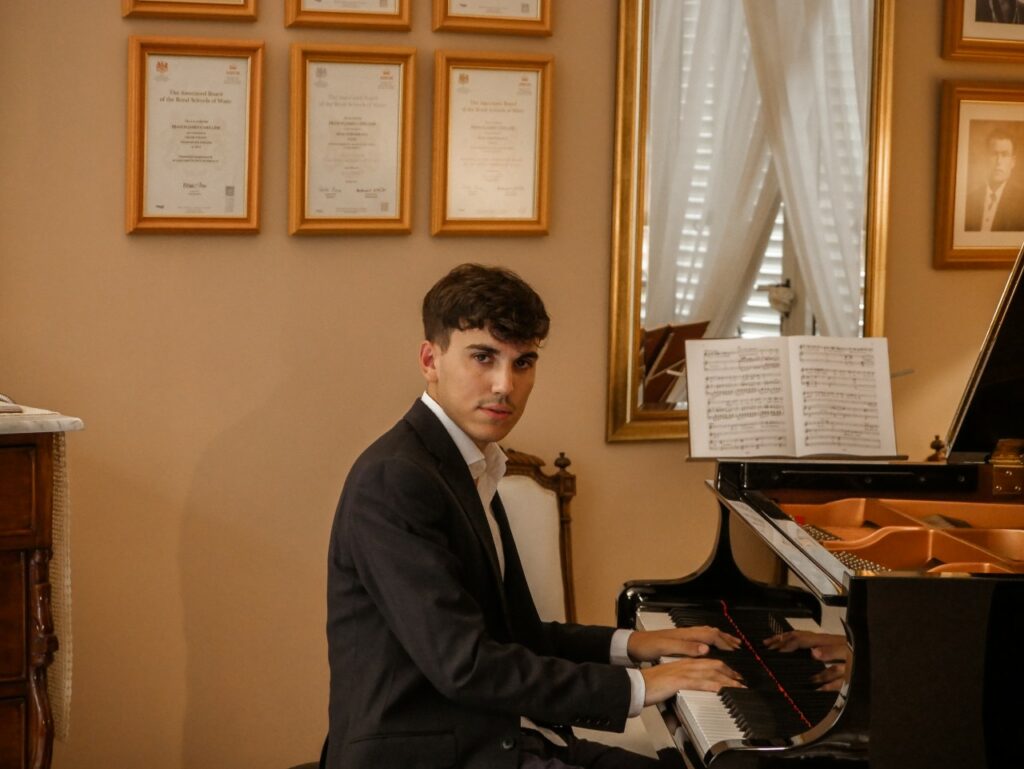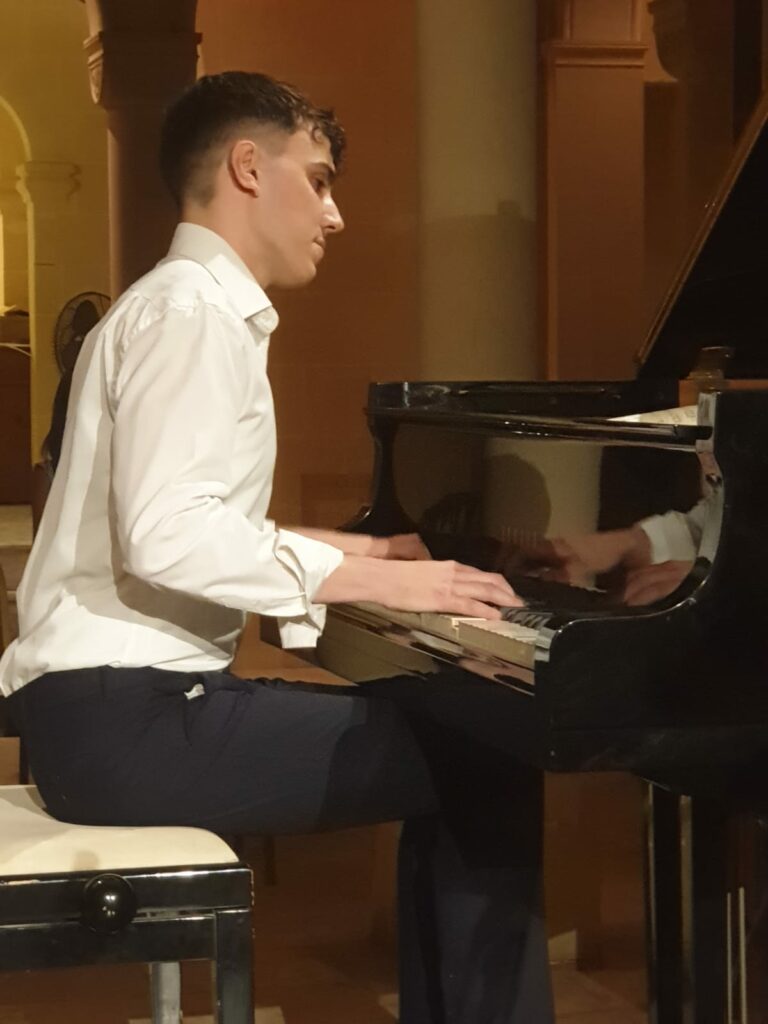OF PROWRESS AND STATURE
One very positive aspect of this festival is the opportunity it provides to local performers to display their musical prowess. One of a good number whom I have heard is Francis Camilleri, who I think is now 25 years old. I remember him as a taciturn, grave child crossing over to Malta with an aunt for lessons here. Well, he has grown in stature not only physically but also as a musician and pianist. My earliest recollection of him at the VIAF is as a very able accompanist, which he did for some two years running. Then he was part of chamber ensembles and as he grew more experienced, he ventured on as a soloist. To watch a musician making steady progress over the years is one of the most satisfying experience one could have.
That Francis Camilleri is a Beethovenian is no secret to those who know him, and, those who have been to his recitals. If not all Beethoven he would certainly include at least one work of his. I know that his aim is to have performed all 32 piano sonatas by 2027, the bicentenary of Beethoven’s death. I think that (I stand to be corrected) with the three he performed this evening he is coming close to the halfway mark. I do not think he follows a chronological order and his choice of the 24th, 25th and 26th Sonatas were chosen for their relative brevity, meant to be performed without undue interruption. That was to provide a very brief break before the second part of the concert which was almost as long as the three sonatas combined.
The choice began with the Sonata in F sharp Major, Op. 78 (À Thérèse ) dedicated to Gräfin Theresia von Braunschweig, or Teréż Brunsvik de Korompa. She was one of many ladies who all happened to be aristocratic. His infatuation with or love for them was always doomed in that strict social order of the time when this great genius was still considered a social inferior. Op. 78 began with a rather solemn introduction which led to one of Beethoven’s most memorable themes. This Adagio cantabile is one practically everybody knows, but, without necessarily knowing from which of Beethoven’s works it comes. The loving, warm atmosphere conveyed was very evident with a contrasting Allegro ma non troppo, to conclude with a lively and very happy Allegro vivace. (Apparently the great Maestro was still harbouring some hope of success with his courtship!)
Sonata No. 26 in G Major, Op. 79’s approximately 10-minute duration makes it about the same length as its predecessor. It opens with an unusually boisterous Presto alla tedesca, then becoming a sort of duet between two cuckoos until the original theme appears, but,with a cuckoo effect returning here and there. This is a very endearing aspect of Beethoven’s personality and sense of fun which he did have on occasion. The opposite side of his character which could grow serious and moody, comes out in the slow, highly contrasting Andante. There are frequent changes of humour and colour caused by changes in key and the pianist made this felt all the way. It seemed to be the easiest thing for him to do to go into the concluding Vivace with a lot of zest and verve.
The Sonata in E flat Major, Op. 81a (Les Adieux) is a rare example of Beethoven’s composing a piano sonata with a precise programme. The three movements are a series of situations affecting Beethoven’s high-born pupil and friend, His Imperial and Royal Highness Archduke Rudolf of Habsburg-Lorraine, youngest brother of Emperor Franz I. Beethoven had to bid him farewell when Napoleon occupied Vienna for the second time in 1809. The first movement, Das Lebewohl (Les Adieux. The Farewell), is an Adagio – Allegro wherein is the sadness of farewell forced upon the two friends. Yet hope is rekindled in the knowledge of the Archduke’s being far away and safe from danger. The hope of a safe return is reflected in the music which is one of optimism despite obvious hurdles. Deep sadness prevails in Abwesenheit (L’Absence. The Absence). Here is a continuous uncertainty; sadness is still acute and is felt in the music as projected, as in this case in the Andante espressivo, by a skilled and sensitive pianist. The final Das Wiedersehen, (Le Retour, The Return) is a Vivacissimo splendidly performed celebrating the Archduke’s return to Vienna where soon after his brother the Emperor buys peace with Napoleon by giving him his eldest daughter Maria Luise’s hand in marriage. At least this was a happy ending for the Archduke, the bride’s uncle, and the composer as well.
The second part of the recital was a splendid tour of an exhibition of paintings as described by Mussorgsky in his Pictures at an Exhibition. Of course, as was very beautifully relayed by the gallery guide, in this case pianist Francis Camilleri. This must be one of the most famous piano suites ever composed. A dilemma almost threatens to overcome my puny self. Having first heard it and fallen in love with it via Ravel’s superb orchestral version of it, I try to repel any recall of it. My perplexity lies here: is the piano writing really so “orchestral” in nature or do I hear such effects because I recall Ravel’s version. There comes a point where in order to banish the thought I concentrate on the piano’s sound, the dynamics, the colour, the feeling with every picture’s interpretation punctuated by a number of light connecting promenades. One has to let go to all this and what a splendid job it was. The children at play, the chatter of the market women of Limoges, the solemnity of an abandoned castle and the sombre catacombs of Paris, Bydlo and the scampering of chicks still partly in their shells. One of my favourites is Goldenberg and Schmuyle when one could almost see the forbidding, rich, powerful Jew and the poor, snivelling. They all came alive so vividly and joining the favourite list is Baba Yaga which paves the way for the most magnificent of all, the Great Tower Gate of Kiev, which remained in the imagination, was painted but never built. So grand, grand, GRAND!
As his uncle George said of him at the end, Francis is one of few words and indeed after all that Mussorgskian drama, he silently fetched the music of the (unannounced) encore and launched into Schubert’s A flat Major Impromptu, Op. 142, n.2. He barely looked at the score. The sheer contrast with the previous glorious bombast sounded so exquisitely tender in the outer sections of this Impromptu that it brought tears to my eyes.
Albert George Storace






